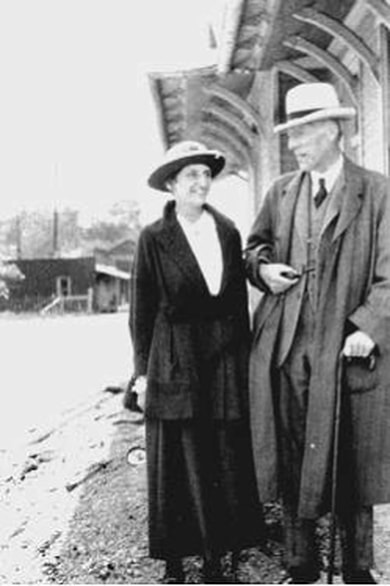MY DEAREST DEAR

An inescapable theme in folk songs is that of lovers about to be parted, but this interpretation was first documented in America in the early twentieth century.
During the years 1916 to 1918, Maud Karpeles and Cecil Sharp (pictured) made a number of expeditions to the Southern Appalachian Mountains to make a compilation of folk songs. They collated more than 500 songs, most of which had been brought with European migrants in the 1700s.
In those days, the highland region acted as a barrier between the mountain communities and the rest of the world. Extremely isolated, the people were largely illiterate, lived in log cabins, spun and weaved their own clothing, and ate what they grew. Singing was part of everyday life, so there was no such thing as a concert or even a community singalong in the mountains because nearly everyone sang.
According to Karpeles, "It would often happen that we would hear a voice in the distance and then, following it up, we would find perhaps a man singing as he hoed his corn patch, or a girl milking a cow, or a woman nursing a baby." My Dearest Dear may have been voiced by any of these people, and many others besides.
Indeed, given the ubiquity of the theme of lovers parting, these lyrics could very well have come from almost any culture at any point in history. Twenty-first century Australia, early twentieth century America, first century Palestine; the sentiment is timeless and universal. One wonders, in the context of Iscariot, who might be singing to whom.
PREVIOUS // NEXT
Sources:
Eighty English Folk Songs, Cecil J. Sharp and Maud Karpeles, Faber: London, 1968
The Ballad Index, Robert B. Waltz and David G. Engle, 2013
During the years 1916 to 1918, Maud Karpeles and Cecil Sharp (pictured) made a number of expeditions to the Southern Appalachian Mountains to make a compilation of folk songs. They collated more than 500 songs, most of which had been brought with European migrants in the 1700s.
In those days, the highland region acted as a barrier between the mountain communities and the rest of the world. Extremely isolated, the people were largely illiterate, lived in log cabins, spun and weaved their own clothing, and ate what they grew. Singing was part of everyday life, so there was no such thing as a concert or even a community singalong in the mountains because nearly everyone sang.
According to Karpeles, "It would often happen that we would hear a voice in the distance and then, following it up, we would find perhaps a man singing as he hoed his corn patch, or a girl milking a cow, or a woman nursing a baby." My Dearest Dear may have been voiced by any of these people, and many others besides.
Indeed, given the ubiquity of the theme of lovers parting, these lyrics could very well have come from almost any culture at any point in history. Twenty-first century Australia, early twentieth century America, first century Palestine; the sentiment is timeless and universal. One wonders, in the context of Iscariot, who might be singing to whom.
PREVIOUS // NEXT
Sources:
Eighty English Folk Songs, Cecil J. Sharp and Maud Karpeles, Faber: London, 1968
The Ballad Index, Robert B. Waltz and David G. Engle, 2013
